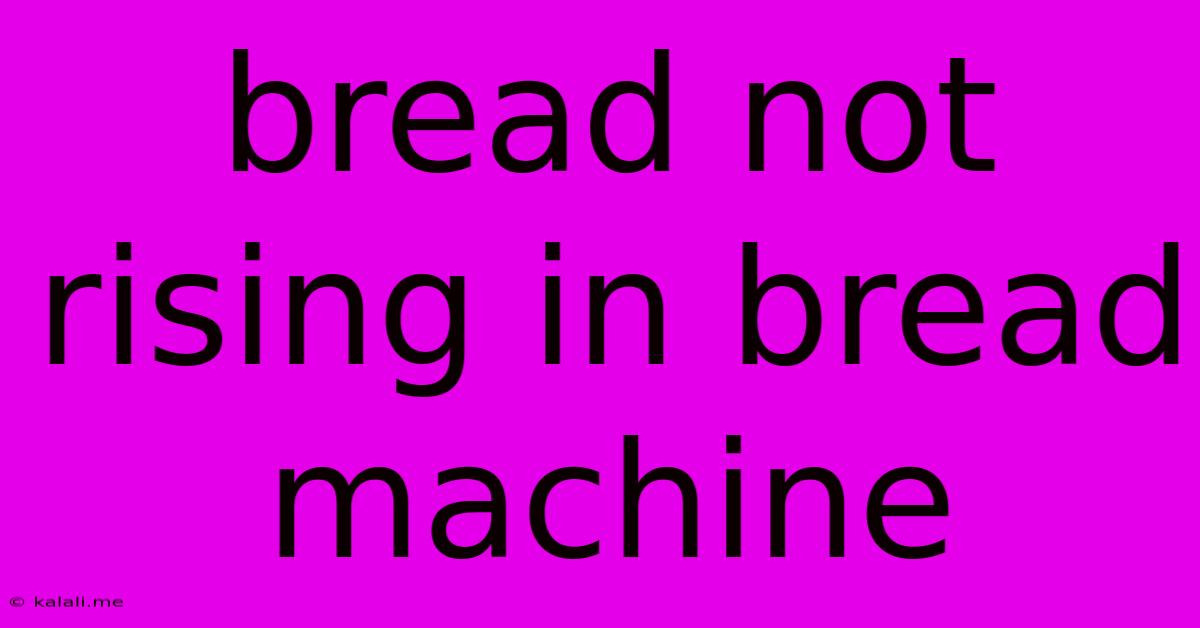Bread Not Rising In Bread Machine
Kalali
May 22, 2025 · 4 min read

Table of Contents
Why Isn't My Bread Rising in the Bread Machine? Troubleshooting Common Issues
So, you've excitedly poured your ingredients into your bread machine, selected your favorite cycle, and waited patiently for the delicious aroma of freshly baked bread. But instead of a golden-brown loaf, you're greeted with a flat, dense disappointment. Don't worry, this is a common problem! This article will troubleshoot the reasons why your bread isn't rising in the bread machine and provide solutions to help you achieve that perfect, fluffy loaf.
Meta Description: Frustrated with flat bread from your bread machine? Learn the common causes of bread not rising, from ingredient issues to machine malfunctions, and get expert tips to achieve perfect loaves every time.
There are several reasons why your bread might not be rising properly. Let's delve into the most common culprits:
1. Ingredient Issues: The Foundation of a Good Loaf
The quality and quantity of your ingredients directly impact the rising process. Even small discrepancies can lead to a dense, unrisen loaf.
-
Yeast: Inactive or old yeast is the most frequent cause of bread not rising. Check the expiration date on your yeast packet. If it's expired or you suspect it's old, replace it with fresh yeast. Make sure you're using the correct type of yeast (active dry or instant) as specified in your recipe. Improper activation of the yeast can also be a problem; follow the recipe's instructions carefully. If using active dry yeast, ensure it dissolves properly in warm water before adding other ingredients.
-
Flour: Using the wrong type or amount of flour can significantly impact the rise. Bread flour, with its higher protein content, is best for achieving a good rise. All-purpose flour can work but might result in a slightly less airy loaf. Measure your flour accurately – using a kitchen scale is recommended for consistent results, as scooping flour can lead to inaccurate measurements and affect the gluten development.
-
Liquids: The temperature of the liquid you use (usually water or milk) is crucial. Yeast thrives in warm temperatures, typically between 105-115°F (41-46°C). Too cold, and the yeast won't activate; too hot, and you'll kill it. Use a thermometer to ensure the liquid is at the correct temperature. The amount of liquid is also vital; incorrect measurements can lead to a dough that’s too dry or too wet, both hindering the rise.
-
Salt: While salt is essential for flavor and gluten development, too much can inhibit yeast activity. Double-check that you haven't added too much salt by mistake.
-
Sugar: Sugar provides food for the yeast. Insufficient sugar can lead to poor rising. However, too much sugar can also be detrimental, creating a hypertonic environment that can dehydrate the yeast.
2. Machine Malfunctions: Is Your Bread Machine Working Correctly?
Sometimes, the problem isn't the ingredients, but the machine itself.
-
Faulty Heating Element: A malfunctioning heating element might not reach the correct temperature, preventing proper yeast activation and dough rising. Check your bread machine's manual for troubleshooting tips specific to heating issues.
-
Kneading Blade Issues: If the kneading blade isn't properly functioning, the dough might not be kneaded sufficiently, affecting gluten development and the overall rise. Check if the blade is properly inserted and spinning correctly during the kneading cycle.
-
Incorrect Settings: Ensure you've selected the right settings on your bread machine – including the correct loaf size and crust color. Incorrect settings can result in under-baked or improperly risen bread. Consult your bread machine's manual for proper usage.
3. Other Factors to Consider
-
Altitude: High altitudes can affect rising due to lower air pressure. You might need to adjust your recipe, particularly the amount of yeast or liquid, to compensate.
-
Room Temperature: A very cold kitchen might slow down the rising process.
Tips for Success: Baking Better Bread
- Fresh Ingredients: Always use fresh ingredients, especially yeast.
- Accurate Measurements: Use a kitchen scale for precise measurements of flour and other ingredients.
- Proper Yeast Activation: Follow instructions carefully for activating your yeast.
- Check your machine: Regularly inspect your bread machine for any signs of malfunction.
- Experiment with Recipes: Try different recipes and adjust them based on your results and altitude.
By carefully examining your ingredients, machine, and baking environment, you'll be well on your way to achieving perfectly risen bread every time! Remember, consistent baking is a process of learning and refinement. Don’t be discouraged by a few unsuccessful attempts; keep experimenting and you will soon be enjoying delicious homemade bread.
Latest Posts
Latest Posts
-
How Do I Stop My Floor From Squeaking
May 22, 2025
-
Switch 2 Gang 2 Way Wiring
May 22, 2025
-
How Much Horsepower Does A Plane Have
May 22, 2025
-
How To Plug Guitar Into Pc
May 22, 2025
-
What Is The Difference Between Double And Single Cream
May 22, 2025
Related Post
Thank you for visiting our website which covers about Bread Not Rising In Bread Machine . We hope the information provided has been useful to you. Feel free to contact us if you have any questions or need further assistance. See you next time and don't miss to bookmark.